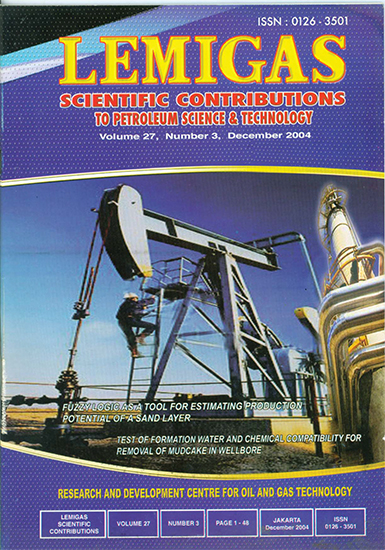Fuzzy Logic As A Tool For Estimating Production Potential Of A Sand Layer
DOI:
https://doi.org/10.29017/SCOG.27.3.872Keywords:
production, potential, Sand LayerAbstract
In production management, a prior knowledge over production potential of a candidate sand layer (geological complexity in Indonesia has led to existence of stratified reservoirs with a set of layers) to be opened is always desirable. The common practice performed during drilling and completion activities of a production well is through the use of well testing and fluid sampling. From the test, fluid dynamic data such as total liquid rate, water cut, and gas cut are produced. A similar set of data is also required for more mature fields for the purpose of monitoring through the running of routine production and/or swab tests.
Although the tests, especially flow tests during drilling and completion, are always regarded as the only source of proof about productive layer(s) production potential, an alternative means that can be used to provide estimates is always desired. The main reason is that flow tests are costly so that only layer(s) considered as the most potential are to be assigned for testing. Layer(s) that are considered less potential are left untested, eventhough in some cases they are also set on production during the well's production phase.
The idea of establishing a method that can provide illustration over production potentials of all layer(s) always exists. Certainly, there are approaches to serve the purpose such as productivity index (PI) analogy and petrophysical through fractional flow measurement in a core laboratory. However, those approaches are often considered inadequate in accommodating various factors that may influence production potential.
To materialize the idea stated above, the pattern recognition approach was taken. This approach was taken in order to model the relationships between various fac- tors in wellbore and production potential without being trapped by the certain complexity that occurs in any mathematical expressions trying to explain the relationships. For the purpose, fuzzy logie (a branch in Artificial
Intelligence) has been used. The choice is actually based on its ability to accommodate both numeric and non-numeric data. Some non-numeric data such as lithology and pore system also have some degrees of influence on production potential. With a tool that enables us to have production potential estimates of reservoir layers, from which layers with the most promising potential are taken to undergo flow tests. Furthermore, as flow test data has been acquired and used as feedback and calibration by the fuzzy model, production potential of layer(s) with less promising or ambiguous prospect can also be predicted.
References
Kusumadewi, S. (2002). Analisis dan Desain Sistem Fuzzy Menggunakan Tool Box Matlab. Graha Ilmu, Perum Candi Gerbang Permai - Yogyakarta 55511, p.276.
Mamdani, E.H. and Assilian, S. (1975) An Experi- ment in Linguistic Synthesis with A Fuzzy Logic Controler. Internationanl Journal on Man-Machine Studies 1- 13.
Wong, K.W., Wong, P.M., Gedeon, T.D., and Fung, C.C. (2003). A State-of-the-Art of Fuzzy Logic for Reservoir Evaluation. APPEA Journal, p:587 - 593.
Downloads
Issue
Section
License
Copyright (c) 1970 SCIENTIFIC CONTRIBUTIONS OIL AND GAS (SCOG)

This work is licensed under a Creative Commons Attribution 4.0 International License.
Authors are free to Share — copy and redistribute the material in any medium or format for any purpose, even commercially Adapt — remix, transform, and build upon the material for any purpose, even commercially.
The licensor cannot revoke these freedoms as long as you follow the license terms, under the following terms Attribution — You must give appropriate credit , provide a link to the license, and indicate if changes were made . You may do so in any reasonable manner, but not in any way that suggests the licensor endorses you or your use.
No additional restrictions — You may not apply legal terms or technological measures that legally restrict others from doing anything the license permits.














